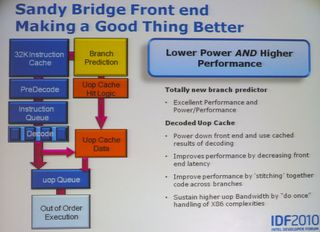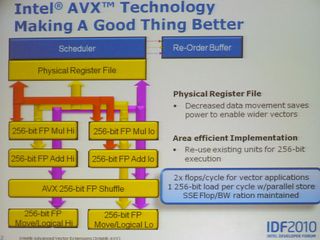Sandy Bridge
New microarchitectures from Intel are always greeted with a mixture of excitement and trepidation, ever since Netburst arrived on the scene. While the Pentium 4 generation was arguably a successful one from a revenue standpoint, it proved to be something of a heat-prone dead end. Conroe redeemed Intel’s reputation, and the next generation, Nehalem, enhanced the company’s reputation even more. Will the third new redesign since Netburst continue to improve?
When it comes to the overall product mix, Sandy Bridge, or as Intel is calling it, “Second Generation Core Architecture,” will eventually consolidate the mainstream and mobile product lines into one process generation. The current mainstream desktop lineup consists of Lynnfield (45 nm quad-core) and Clarkdale (32 nm dual-core.) Mobile CPUs are similarly bifurcated as Clarksfield (45 nm quad-core) and Arrandale (32 nm dual-core.)
Sandy Bridge will be available in both dual- core and quad-core versions for both desktop and mobile PCs. Intel’s next-generation HD graphics will be fully integrated onto the CPU die--not just the package, as was the case with Arrandale/Clarkdale.
As with Nehalem and Westmere, Sandy Bridge has a split L1 cache with separate data and instruction caches, and a dedicated 256 KB L2 cache per core.

The Processor
Built on Intel’s existing 32 nm process, the microarchitecture includes a variety of key enhancements to the current Westmere/Nehalem architecture:
- A new cache was added for decoded micro-ops (uOps). When loading decoded uOps from this cache, the x86 decode pipeline is turned off, saving power. Improvements were made to the branch prediction engine, improving overall throughput.

- The architecture now supports two load/store ports, instead of just one. The data cache can handle two reads and one store per clock cycle.
- The out-of-order execution engine was rebuilt from scratch, which was needed because Intel wanted to integrate support for 256-bit AVX floating point instructions into the pipeline. The AVX pipeline now includes a physical register file, decreasing data duplication and transfers. Intel estimates that use of the new instructions will increase floating point throughput 2x over the current SSE implementation. Note that Windows users will need Windows 7 SP1 (currently in beta) in order for apps to make use of AVX.

The overall CPU is highly modular, allowing Intel to easily build chips with differing numbers of cores, cache sizes, and even GPU execution units.
Stay on the Cutting Edge
Join the experts who read Tom's Hardware for the inside track on enthusiast PC tech news — and have for over 25 years. We'll send breaking news and in-depth reviews of CPUs, GPUs, AI, maker hardware and more straight to your inbox.

Raspberry Pi robot uses AI to motivate runners by shouting encouraging messages

TSMC says it doesn't need High-NA EUV chipmaking tools for 1.6nm-class node — in contrast, Intel has championed the tech

Grab the Montech Air 903 Max PC case for just $69 — great value for a high airflow case with four PWN fans
-
dragon5677 hope the day comes soon when sandy bridge is released with a surprisingly low price.Reply -
kashifme21 No point of having such powerful hardware, when 95% of current games can be run on a dual core cpu and an 8800gtx gpu @ max settings.Reply
Intel, Nvidia and AMD should rather pursue game developers to make use of current hardware instead of throwing newer hardware which most likely will be unused.
Sandy Bridge aint needed for Web surfing or using Word pad any 8yr old CPU is enough for that. Bring on the games or i am not interested in any more upgrades. -
Tamz_msc ReplyOverall, Sandy Bridge looks to be a solid mainstream offering. Performance enthusiasts should note that LGA 1366 is not going away, and Westmere-based hexa-core CPUs will continue to be offered. Intel even suggested that future LGA 1366 offerings may become available, but wasn’t prepared to make any definitive announcements.
Unless they are offered at reasonable prices, I see no point in people investing in LGA 1366. -
jfby I don't think it's so much that people will want to invest in LGA 1366 but rather Intel will not support anything else.Reply
The argument to have only 16 lanes available doesn't seem legit; 'mainstream' gamers aren't going to buy a 1366 system at the moment.
At least people who have bought a 1366 have a potential for an upgrade 2-3 years from now, though I'm sure the better choice will just be a brand new system, again. -
pjmelect Intel graphics even at twice the speed, no thanks. AMD could take a big lead over Intel if they integrate ATI graphics in their CPU's.Reply -
ScrewySqrl dragon5677hope the day comes soon when sandy bridge is released with a surprisingly low price.Reply
Low priced? from Intel? You must be joking -
atdhe kashifme21No point of having such powerful hardware, when 95% of current games can be run on a dual core cpu and an 8800gtx gpu @ max settings.Intel, Nvidia and AMD should rather pursue game developers to make use of current hardware instead of throwing newer hardware which most likely will be unused.Sandy Bridge aint needed for Web surfing or using Word pad any 8yr old CPU is enough for that. Bring on the games or i am not interested in any more upgrades.Reply
You know, a computer can be used for more than just gaming, surfing or Word ;) -
Trueno07 more info here:Reply
http://www.anandtech.com/show/3922/intels-sandy-bridge-architecture-exposed -
wolfram23 Glad to be missing this generation, as I just got an i5 750 earlier this year. Won't need to upgrade until at the earliest Ivy Bridge.Reply
I don't really like how so much die space gets wasted on their P67 platform. Hopefully they make special CPUS that are a little beefier and no on-die graphics for that chipset... tho it's unlikely.
Most Popular

